Fantastic photographs from the Ffestiniog Railway
Posted by Chris Graham on 12th March 2024
Simon Colbeck reports from one of the traditional autumn photographers’ charters on the Ffestiniog Railway; a highlight of 2023.
Photography: Simon Colbeck
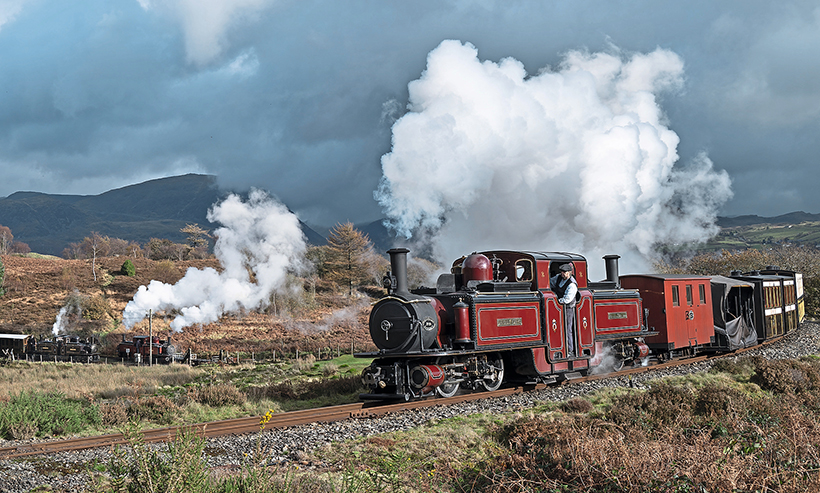
Double Fairlie Merddin Emrys, built at Boston Lodge in 1879, climbs the spiral at Dduallt. Arriving in the siding, David Lloyd George passes James Spooner. Three double Fairlies in one!
The narrow-gauge railways of Wales have a unique charm and character. For many years now at the end of the running season on the Ffestiniog and Welsh Highland railways a series of ambitious photographic charters have taken place with enthusiasts from around the world congregating in Porthmadog to enjoy the spectacle of narrow-gauge steam working in the stunning Snowdonia national park.
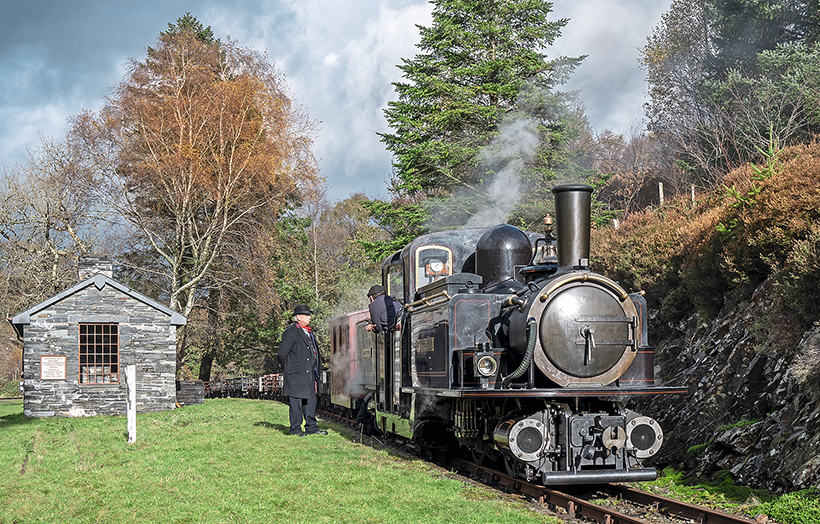
2023-built double Fairlie James Spooner sits in Dduallt station.
This year was no exception with a series of charter trains heading off from Porthmadog during the first week of November. This was proceeded by two days on the equally impressive Vale of Rheidol railway at Aberystwyth. Finally a visit was made to the home of railway preservation in the UK, the Talyllyn Railway, for another two days of charters in the magnificent Welsh hills.
There was also an additional two days of activity organised at the Welshpool & Llanfair railway which, sadly, I didn’t have time to participate in this year.

Boston Lodge engine shed with three double Fairlies all in steam. On the mainline Merddin Emrys impatiently blows off into the night sky.
The history of the 25-mile Welsh Highland Railway (WHR) is a long and complex one. Initially formed by the merger of two smaller concerns, the original WHR was never a commercial success and after various guises of ownership, including a stint under the Ffestiniog Railway, the last train ran in 1937.

Merddin Emrys rushes back to Porthmadog along the causeway known as the Cob as the sun sets into the sea
Restoration of the line started in 1997 and took until 2011 to complete. Now a major tourist attraction in the region the modern railway today runs through to the coast at Caernarfon utilising the trackbed of the former LNWR line, with which the original WHR connected at Dinas junction.
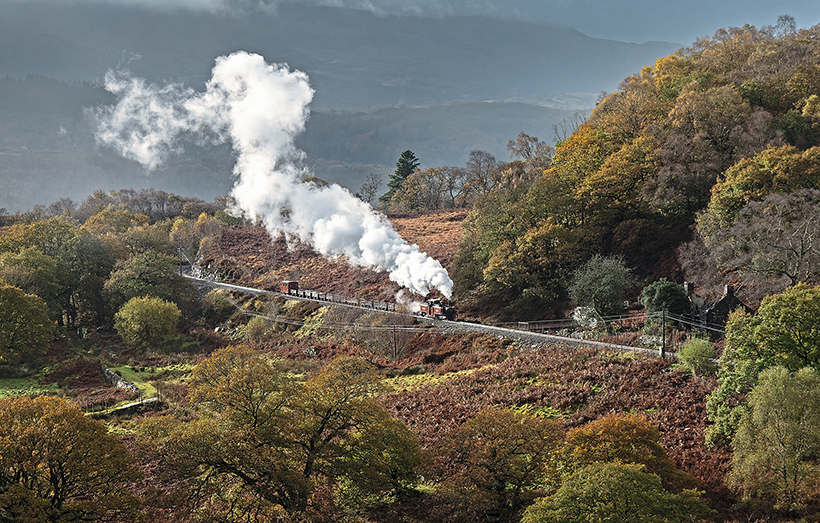
Double Fairlie David Lloyd George heads a rake of slate wagons up towards the new Moelwyn tunnel under a very gloomy sky.
The current WHR is run by the Ffestiniog Railway, while the earlier Welsh Highland Heritage Railway preservation group operates a one-mile line out of Porthmadog.
The scenic splendour of the Welsh Highland Railway is simply breath-taking. From the Aberglaslyn pass to the ‘S’ curves at Rhyd Ddu at the foot of Snowdon the railway is a photographer’s paradise.

David Lloyd George on the Welsh Highland railway rounds the ‘S’ curves on the approach to Rhyd Ddu at the foot of Snowdon.
The WHR connects to the Ffestiniog Railway at Porthmadog harbour station giving nearly 40 miles of 2ft gauge railway to explore.
Leaving Porthmadog, the railway follows the spectacular sea wall known as the Cob before commencing a continuous climb up to the former slate mining town of Blaenau Ffestiniog. The route includes the UK’s only spiral climb section at Dduallt where the line gains 35 feet in height to follow a higher alignment of the track bed needed when the line reopened in the 1970s.
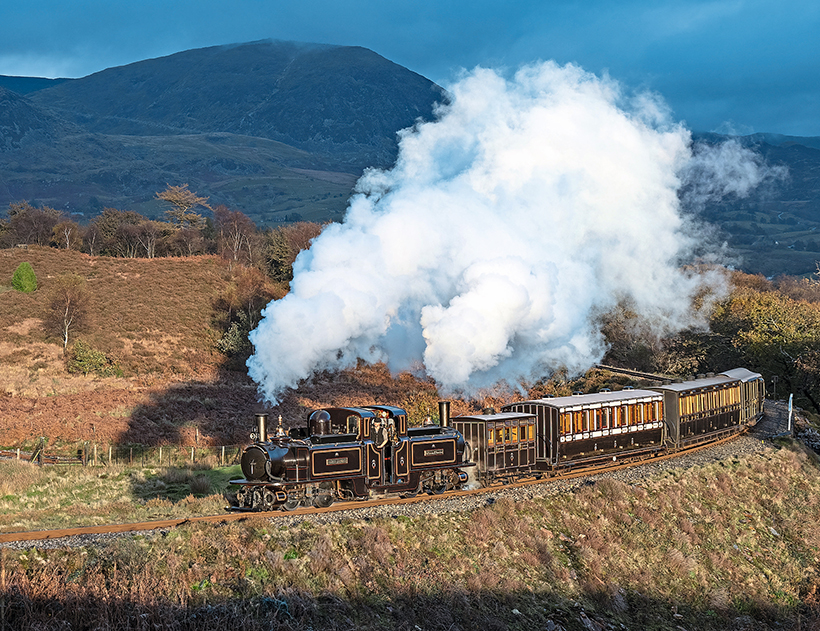
New-build double Fairlie James Spooner climbs the spiral at Dduallt with a superb rake of matching heritage coaching stock
The Ffestiniog is blessed with a remarkable collection of original locomotives which worked the line, including of course the fabulous double Fairlies. The highlight of the 2023 charters was the inclusion of new-build double Fairlie James Spooner thus giving the prospect of having three double Fairlies in steam together, not bad when there are only six in existence in the world! The new locomotive takes its name from an earlier FR double Fairlie which was named after the company’s first manager.
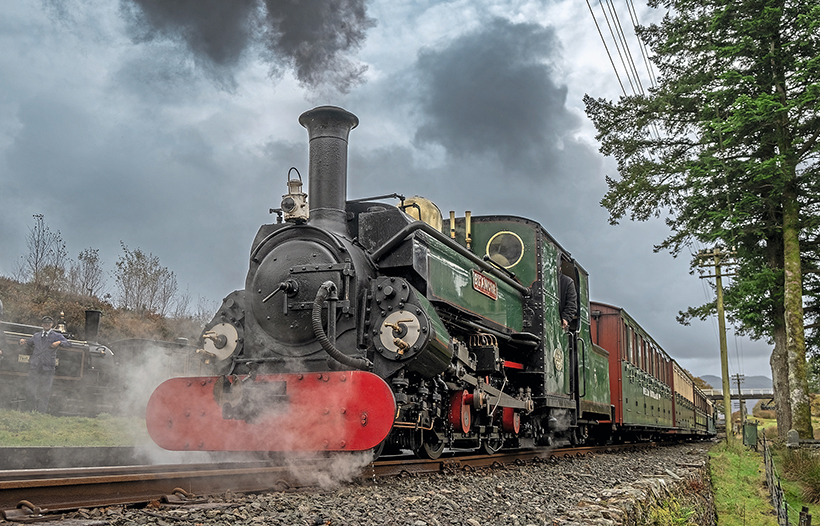
Former Penrhyn Railway Hunslet Blanche opens the draincocks and leaves Dduallt station on the Ffestiniog Railway.
The new James Spooner is the seventh locomotive to be built by the Ffestiniog Railway Company in its workshops at Boston Lodge, and the seventh FR double Fairlie. The building of the new locomotive was announced in 2016 as a replacement for Earl of Merioneth. After a delay due to the Covid pandemic, it was completed in 2023. The power bogies for the new loco and some cab fittings came from the withdrawn Earl of Merioneth. The boiler was built at Boston Lodge with a hybrid riveted/welded design. A novel feature is the removable roof section which allows it to be presented in the style of Merddin Emrys when it was newly built. In this form with the stovepipe chimney the new Fairlie recreates the look of a classic Victorian narrow-gauge locomotive.
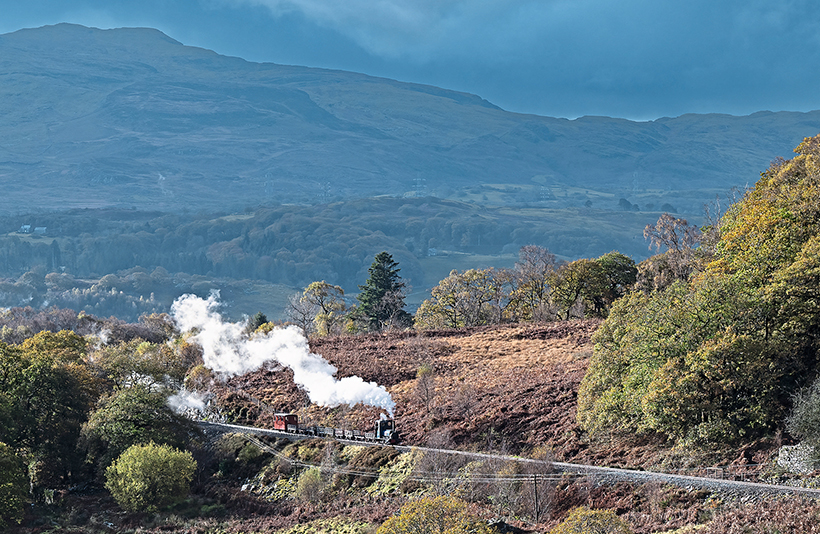
The spectacular scenery of the Ffestiniog Railway is seen to full effect with this view of 1899-built Quarry Hunslet Britomart as it approaches the entrance to the new Moelwyn tunnel.
Very different in feel to both the WHR and the Ffestiniog railways, the first railway on this year’s charter itinerary was the Vale of Rheidol Railway at Aberystwyth. Another 2ft gauge line, it climbs up through the spectacular Rheidol Valley up to the tourist attraction of Devil’s Bridge.
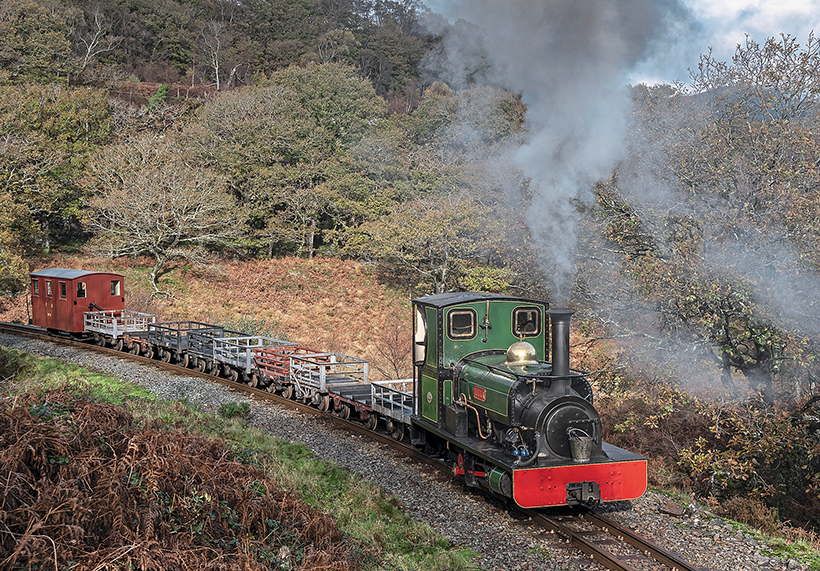
Medium-sized Quarry Hunslet Lilla of 1891 heads round the spiral on the Ffestiniog Railway with a train of slate wagons.
Originally built to serve the lead mines in the valley, the railway had essentially become a tourist operation by the time it was taken into the ownership of the Great Western Railway (GWR) in 1922.
The GWR provided the railway with three Swindon-built new locomotives which were typically GWR in appearance and at 8 feet wide, large locomotives for the 2ft gauge.
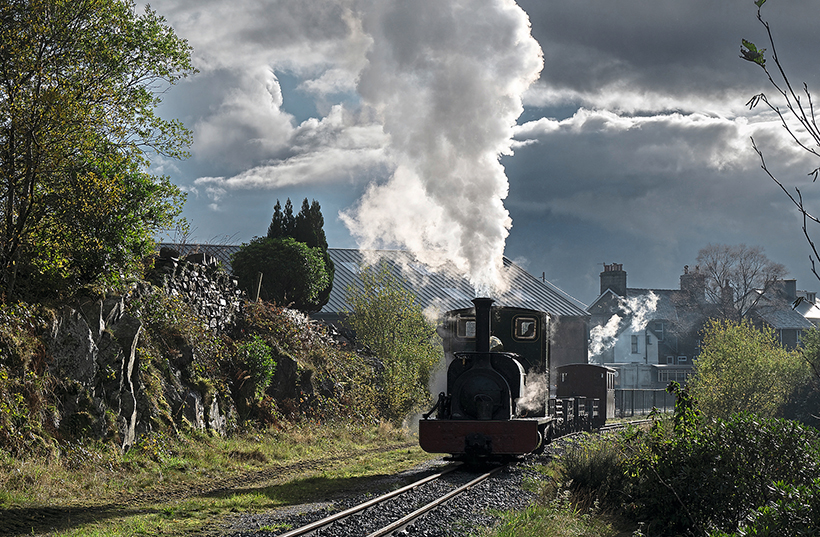
Quarry Hunslet Lilla of 1891 head for the slag tips at Glanypwll near Blaenau Ffestiniog.
These have provided the mainstay of the lines services ever since and are kept in immaculate condition by their full-time crews.
The railway passed from GWR ownership to British Railways upon nationalisation in 1948. It remained the last steam operated line on BR until finally sold under privatisation in 1989 to the trust which currently owns it.
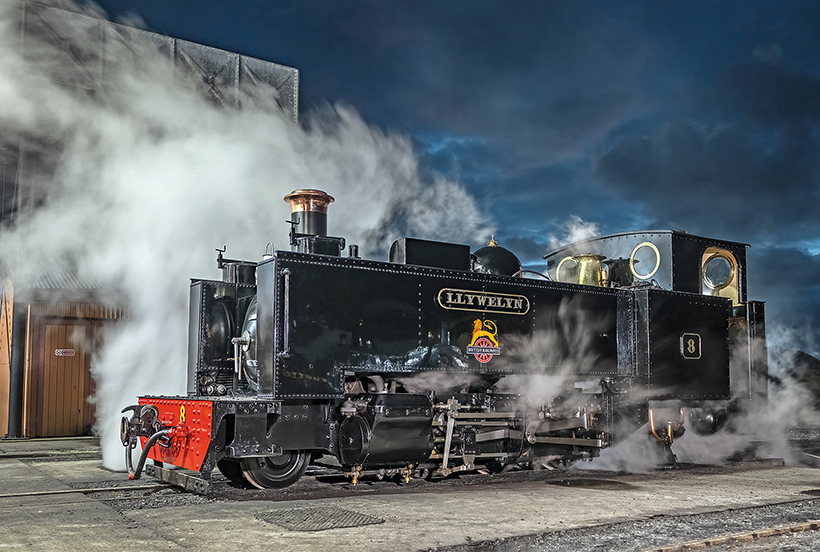
Newly repainted into British Railways black livery, 1923 Swindon-built No.8 Llywelyn blows down on Aberystwyth shed.
Just finished in time for our visit was the repainting of VoR number 8 Llywelyn into British Railways black livery with the early ‘Ferret and Dartboard’ logo. This was paired to the recently repainted blood and custard-coloured coaches which superbly recreated the look of the railway in the early 1950s.
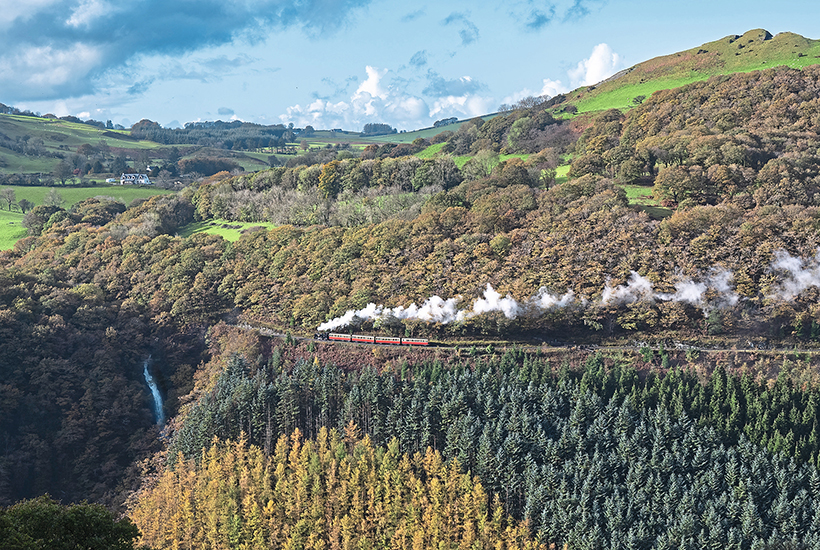
No. 8 Llywelyn climbs up the Vale of Rheidol line towards Devils Bridge station.
The final railway visited was the delightful Talyllyn line, the world’s first preserved steam railway. The Talyllyn Railway starts from Tywyn on the Mid-Wales coast, halfway between Barmouth and Aberystwyth on the A493 road. Opened in 1865 as a narrow-gauge railway powered by steam locomotives, it was originally built to carry slate from quarries in the hills. The quarries closed in 1946 but the daily passenger train carried on.
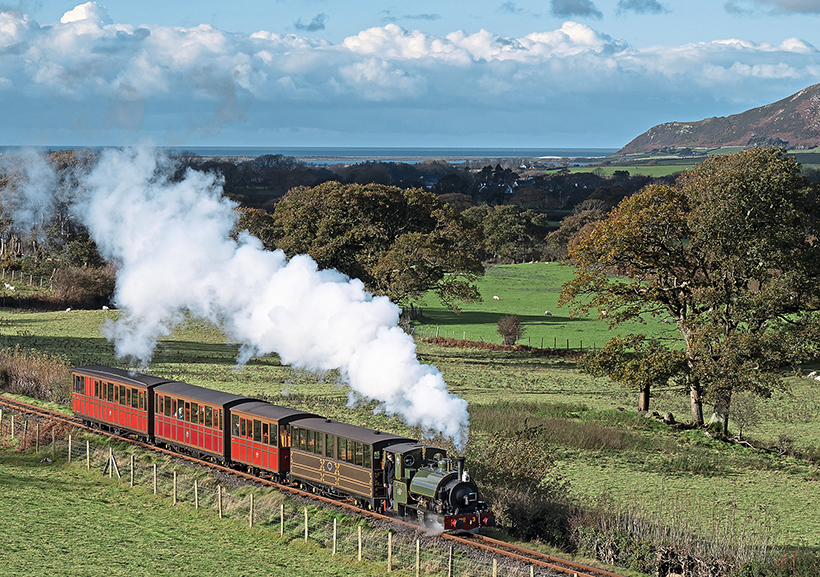
Heading out from the sea at Tywyn, former Corris Railway No. 3 Sir Haydn disturbs the sheep.
In 1951 the railway was taken over by the Talyllyn Railway Preservation Society, the first such in the world, and it is the volunteer members of the society together with a small dedicated full-time workforce who run the railway today.
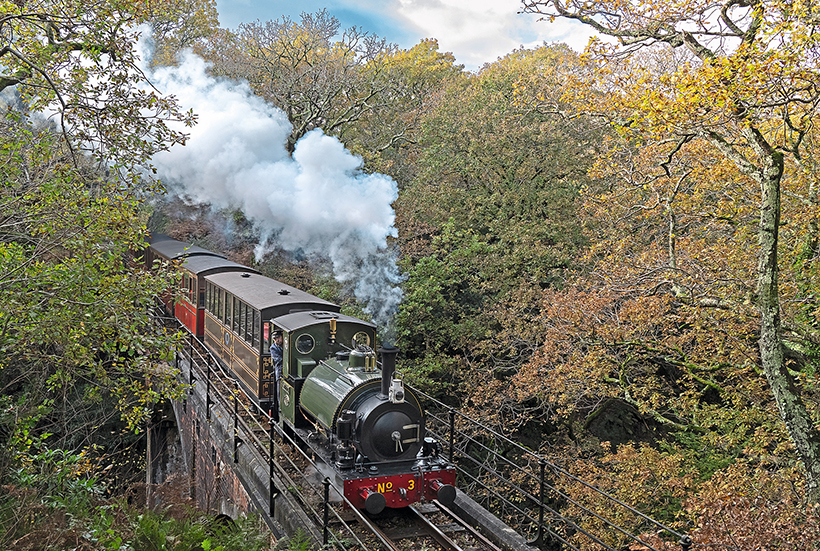
Former Corris Railway No. 3 Sir Haydn, built by Falcon in 1878, passes over the bridge at Dolgoch Falls.
The original two steam locomotives built for the line survive and along with four of the first passenger coaches are still in regular use. The charters used 1866-built Fletcher & Jennings Dolgoch along with former Corris Railway No. 3 Sir Haydn.
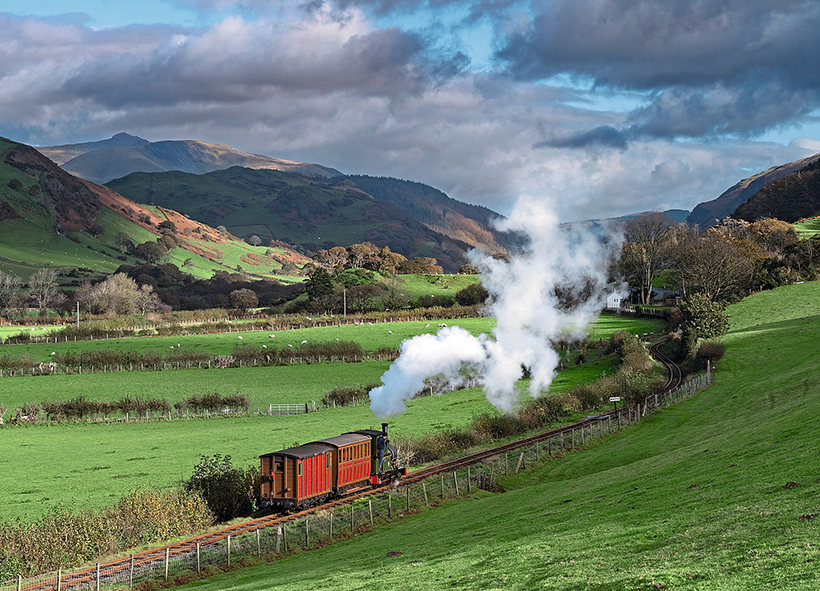
1866-built Fletcher & Jennings locomotive Dolgoch heads for the hills on the Talyllyn Railway.
The four railways visited are all very different in character, but each offer spectacular views and photographic opportunities. The variety of locomotive types and the constantly changing North Wales weather makes this area irresistible to the steam railway photographer.
Thanks to David Williams Charters.
This feature comes from the latest issue of Old Glory, and you can get a money-saving subscription to this magazine simply by clicking HERE
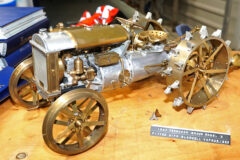
Previous Post
The Jim Russell sale of amazing tractor models
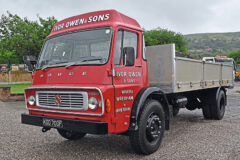
Next Post
An interesting classic lorry collection



